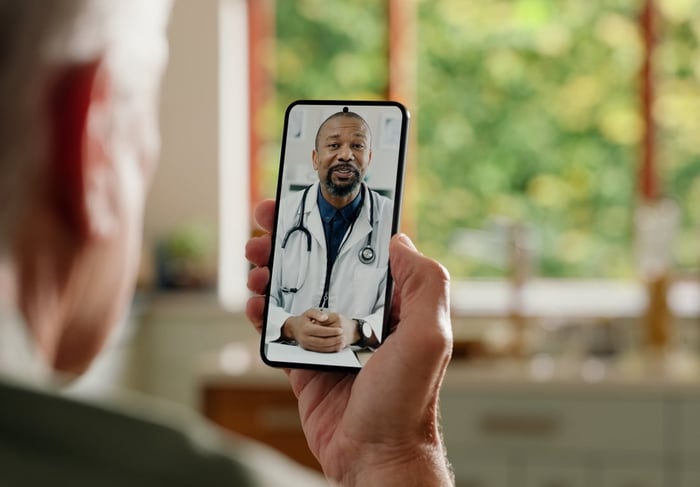Key Points
-
Prevention is key to minimizing healthcare costs.
-
Fall-proofing your home is one of the best preventative measures you can take.
-
Comb through your Medicare benefits to learn which are designed to help you stay healthy.

Image source: Getty Images.
The financial issue that scares me most as I invest for retirement is the high cost of healthcare. After all, no one can predict whether cancer will rear its ugly head or an aneurysm will change life as I know it. Uncertainty makes me uncomfortable.
Where to invest $1,000 right now? Our analyst team just revealed what they believe are the 10 best stocks to buy right now. Learn More »
However, one of the toughest parts of being an adult is learning that life is filled with uncertainty. The best anyone can do is control what they can. Here are some steps you can take to reduce healthcare expenses in retirement.
Focus on preventative care
Heading off health conditions before they become serious is a good way to save on healthcare. And, as a bonus, you’ll feel better and have more energy to do the things that make you happy. When seeking preventative care, you’ll want to look primarily at Medicare Part B, although preventative care can also be accessed through Medicare Advantage plans (which may offer additional benefits).
Here are some examples of preventative care:
- Screenings: Including colonoscopies and screenings for lung cancer, diabetes, hepatitis (B and C), HIV, glaucoma, prostate cancer, and mammograms.
- Vaccines: Vaccinations against the flu, hepatitis B, COVID-19, and pneumococcal infections.
- Wellness visits: An initial preventative physical exam (IPPE) and annual wellness visit (AWV).
- Miscellaneous services: Including bone mass measurements and diabetes self-management classes.
- Counseling services: For health-related issues like weight management, alcohol treatment, tobacco cessation, and mental health services.
Get ready for your closeup
If you’re dealing with a minor health condition or are due for a follow-up visit, take advantage of your doctor’s telehealth options. The best way to determine if your doctor uses telehealth services is to ask them directly. If they do, you’ll likely find it more cost-effective than an in-person visit.
Negotiate medical bills
Don’t hesitate to negotiate the bill with your healthcare provider if you pay out of pocket for a medical service. The high cost of medical care is no secret, and providers understand that patients need a break, so make it a point to ask for a discount.
Fall-proof your surroundings
Falling is the No. 1 cause of fatal and nonfatal injuries for seniors, leading to more than 3 million visits to the ER annually. According to the Centers for Disease Control and Prevention (CDC), 88% of emergency department visits and hospitalizations for hip fractures were caused by falls. However, even a broken wrist or sprained ankle can lay you up and leave you dependent on others.
Falls can be expensive, as they may lead to a period of recuperation during which you’ll need paid help. You may need to pay someone to shop for you, walk the dog, or clean your house.
This is a small sample of steps experts say you can take to fall-proof your home:
- Install an extra handrail: Ensure that handrails are on both sides of any stairs and that they are securely attached.
- Light it up: Check the lighting throughout your house, looking for shaded or dark areas. Consider installing motion-activated lights that plug into electrical outlets. These lights automatically turn on when you walk by, ensuring your path is well lit.
- Keep things tidy: It’s surprisingly easy to trip over an electrical cord, shoes near the stairs, books, or furniture. Before entering a room, look around to ensure nothing could trip you up and make it a point to keep everything in its place.
- Skip the rugs: It may be time to donate any throw rugs or small area rugs scattered throughout your home, as they can be a serious tripping hazard. Nonskid mats are a better option for any floor surface that is likely to get wet (such as outside your shower or in front of the kitchen sink).
- Adopt grab bars: Mount grab bars inside and outside your shower and tub, and near toilets.
While there are businesses that will fall-proof your home for a fee, you should check first with organizations like the Area Agency on Aging or National Council on Aging (NCOA), both of which offer a host of fall prevention resources. And don’t forget to take advantage of available Medicare benefits. Parts A and B cover preventative services that help assess your fall risk, and some Medicare Advantage (Part C) plans cover fall prevention programs.
I recently told someone that I put a small amount of money into a special “healthcare in retirement” savings account each month and was surprised at the bemused smirk on their face. I understand the desire a younger person may have to believe they’ll never get old, or that they’ll never lose any of their current physical prowess. However, if a person is fortunate enough to live a long life, they will deal with changes — and that includes the guy with the smirk.
As I mentioned, uncertainty makes me uncomfortable. That’s why I’m doing what I can to remain healthy, now and into my golden years.
The $23,760 Social Security bonus most retirees completely overlook
If you’re like most Americans, you’re a few years (or more) behind on your retirement savings. But a handful of little-known “Social Security secrets” could help ensure a boost in your retirement income.
One easy trick could pay you as much as $23,760 more… each year! Once you learn how to maximize your Social Security benefits, we think you could retire confidently with the peace of mind we’re all after. Join Stock Advisor to learn more about these strategies.
View the “Social Security secrets” »
The Motley Fool has a disclosure policy.






